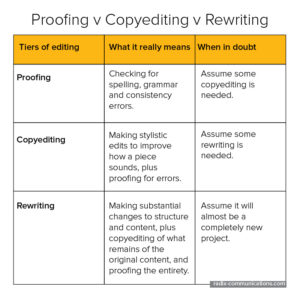It never ceases to amuse me how, in the job of “copywriter”, so much of my work doesn’t actually involve any writing. Clients regularly ask instead for copyediting, proofing, or “wordsmithing” of existing copy.
Here’s the thing, though: all of those tasks are very different – demanding a different set of skills, and taking a very different amount of time.
For the sake of writers and clients alike, I’ll be identifying the differences between them, and hopefully helping everyone better communicate their expectations from the editing process.
Why do clients ask for wordsmithing?
Before getting into the nitty-gritty of different editing jobs, it’s worth examining exactly why clients might ask us copywriters to do this, rather than getting us to write from scratch.
Several scenarios can lead to an editing request:
- Existing content may need to be updated or repurposed for a different format
- The client may think it’s easier to have a go at a draft than to jump on a call or write a brief
- Another writer or agency may have produced a draft, but the client wasn’t happy with it
(There are plenty of other reasons why an edit may be needed, of course, but these are the more common examples we see.)
Interestingly, each one leads to a very different level of editing. While an update might just need you to edit stats and quotes, “polishing” someone else’s first draft may require extensive changes to both content and the structure before it really gleams.
The key takeaway is that understanding why a piece needs editing is half the battle. If you know why an edit is requested, you can make an educated guess as to what level of editing is required.
The different levels of editing
In general, “wordsmithing” jobs tend to fit into different tiers based on the amount that needs changing:
Tier 1: Proofing
Proofing involves spell and grammar-checking, in minute detail. You focus on technical specifics, and trust the original writer has done a bang-up job with style, structure and tone. The job is to meticulously comb for errors (typos, missing words, inconsistency in product naming or punctuation, etc.). It’s quite a specialist skill, and oddly enough writers don’t always make the greatest proofreaders, so as a general rule we don’t usually offer it as a standalone service.
Tier 2: Copyediting
Copyediting involves getting a bit more hands-on with the text. It asks for further stylistic edits to make the writing more pleasing, or more in keeping with a specific tone or voice. This still shouldn’t involve any major structural changes, but it can demand chunks of text are rewritten or stripped entirely to create a more cohesive piece.
Tier 3: Rewriting
The final stage is completely rewriting a piece. This involves changing the copy right down to the structural level, and often means going back to the drawing board and rebriefing entirely. This is the most involved level of editing, and essentially turns the first draft into an extended brief, rather than an actual piece of content.
Not everyone knows what they want
Typically, when a client asks for “wordsmithing”, they mean copyediting. But that isn’t always the case.
Many (particularly those that aren’t usually involved in the copy side of things) use the terms proofing and copyediting interchangeably – often confusing the two. And we occasionally see clients mistakenly think “a quick wordsmith” will save time (and costs), when really a piece needs rewriting from scratch if it’s going to achieve its objective.
It’s important for writers and clients alike to be aware that these misunderstandings are common. Both parties need to come to a shared understanding of what is needed before any proofing or editing work begins. And sometimes, writers need to take a deep breath and be honest about the draft in front of them, and how much work will be required to transform it into really useful content that gets results.
If in doubt, it can help to assume what you actually need to do is one tier more than what you’re asking or being asked for. That way, no one gets trapped in a corner without the time needed to do the copy justice.
Next steps
One day, I hope we can reach a utopian state when clients, agencies and writers are all on the same page about what different editing jobs entail.
Until that day comes, I’ve produced a handy table for you to print off, stick to your desk, and email to your friends and loved ones.

Want more copywriting related tips? Why not sign up for our monthly copywriting tips email.


